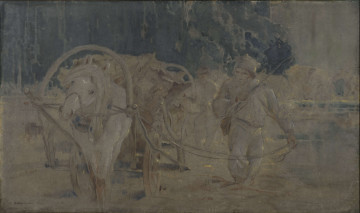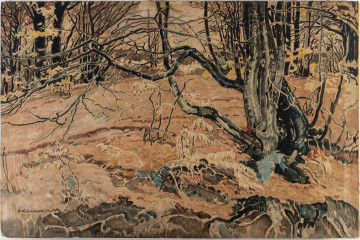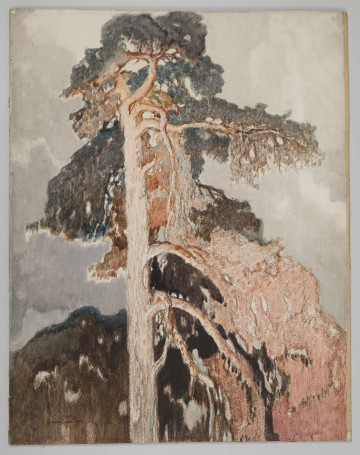
Carting of wood
1922
National Museum in Lublin
Part of the collection: Polish landscape painting (19th–1st half of the 20th c.)
Julian Fałat (1853-1929) is one of the most prominent watercolourists of the turn of the 19th and 20th centuries, creator of the canon of hunting scenes and panoramic landscapes in snowy winter scenery. The artist was very keen on watercolour, which offered the possibility of a quick registration of outdoor studies, obtaining delicate tones or nuances of light and colour. However, he stressed that he reached for this medium for very prosaic reasons; at the beginning of his artistic path he simply could not afford to buy oil paints. His masterful use of watercolours was already evident in Popielec [Ashe Wednesday] (1880-1881), created during his stay in Rome and considered to be one of the most outstanding early works of the artist. Las [Forest], dating from the mature period of Fałat's artistic work, confirms the virtuoso mastery of the watercolour technique, which was pointed out by Mieczysław Treter, writing in "Sztuki Piękne" [Fine Arts] (1925-1926): "None of the Polish painters feels the water in the paint, or rather on the paper, in this way. The paper is wet or damp, and the paint either flows over it or soaks in, combining in semi-accidental phenomena, creating a kind of natural marbles, in which you can feel the style of watercolour [...]. By means of appropriately tuned colour spots, by means of appropriately harmonised expression, Fałat does not give a faithful reflection, a copy, but an artistic equivalent of a motif taken from nature; the artist does not bore with telling details, but only hints and suggests; creating a fresh and vivid excitement for the eye, he forces the imagination to complete the laconic picture, awakens from sleep whole circles of associations, acts directly on the emotional side of human life". In the case of the composition in question, the impression created by nature was characterised by a fragment of the forest selected by the artist. The way of framing and the use of seemingly accidental shots reveal the influence of the Japanese aesthetics, popular in European art at the beginning of the 20th century. It is confirmed by shifting the compositional axis, which is created by a monumental silhouette of a pine tree, simplified, interpenetrating crowns of the remaining trees or a synthesised colour spot. The artist's gaze on nature reveals his admiration for it, his ability to capture its transience in a painterly frame and to see beauty in the smallest fragment of his native landscape.
Anna Hałata
Author / creator
Dimensions
cały obiekt: height: 19,6 cm, width: 29,6 cm
Object type
painting
Technique
aquarel
Material
paper
Creation time / dating
Creation / finding place
Owner
The National Museum in Lublin
Identification number
Location / status

1922
National Museum in Lublin

1921
National Museum in Lublin

1931
National Museum in Lublin
DISCOVER this TOPIC
Castle Museum in Łańcut
DISCOVER this PATH
Educational path